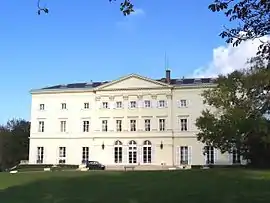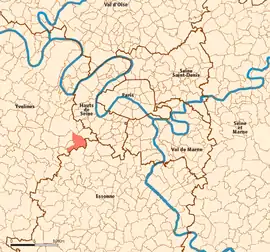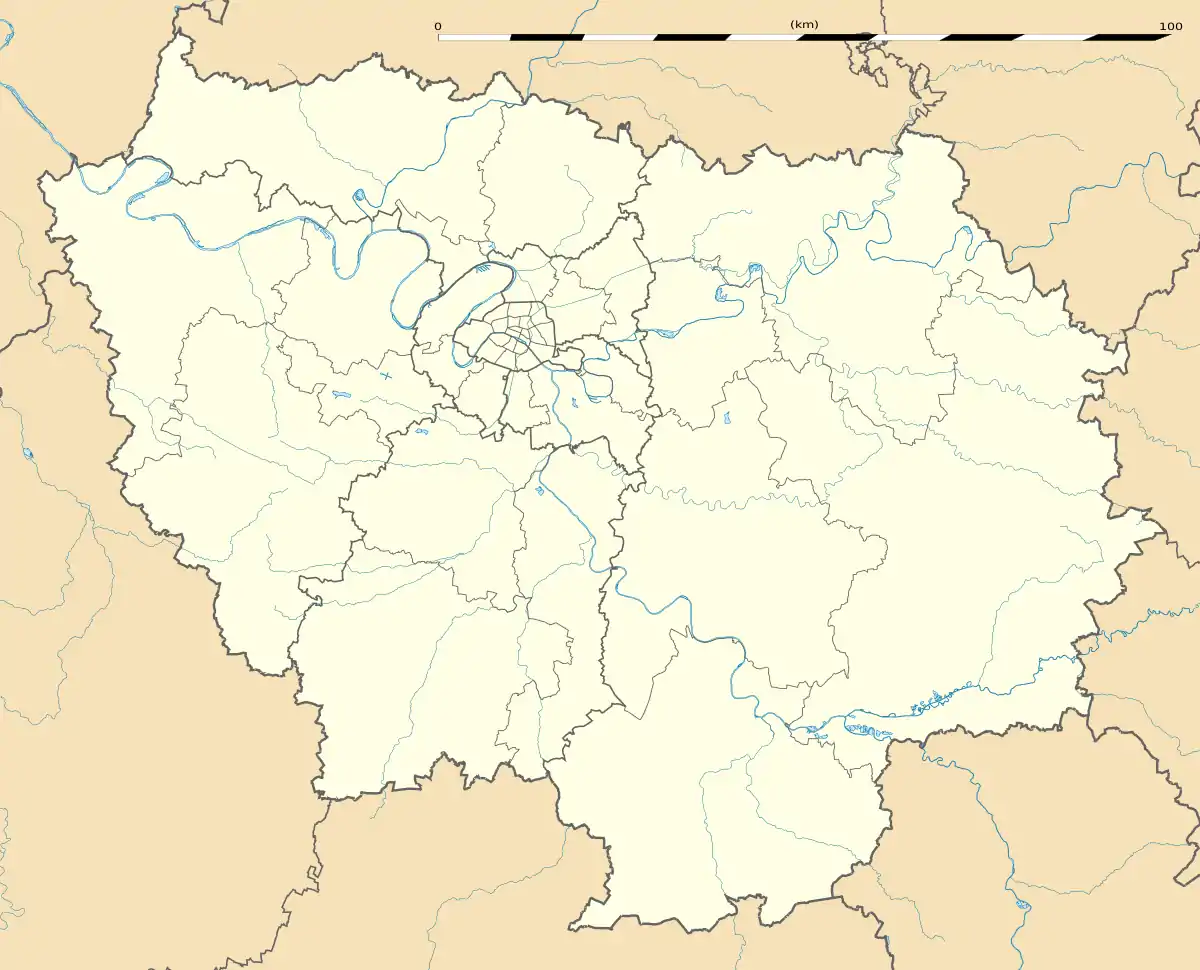Jouy-en-Josas
Jouy-en-Josas is a commune in the Yvelines department in the Île-de-France region in north-central France. It is located in the south-western suburbs of Paris, 16.4 km (10.2 mi) from the center of Paris.
Jouy-en-Josas | |
|---|---|
 Chateau of HEC-CRC | |
 Coat of arms | |
 Location (in red) within Paris inner and outer suburbs | |
Location of Jouy-en-Josas 
| |
 Jouy-en-Josas Location (in red) within Paris inner and outer suburbs  Jouy-en-Josas Jouy-en-Josas (Île-de-France (region)) | |
| Coordinates: 48°46′08″N 2°10′04″E | |
| Country | France |
| Region | Île-de-France |
| Department | Yvelines |
| Arrondissement | Versailles |
| Canton | Versailles-2 |
| Intercommunality | CA Versailles Grand Parc |
| Government | |
| • Mayor (2020–2026) | Marie-Hélène Aubert |
| Area 1 | 10.14 km2 (3.92 sq mi) |
| Population (2017-01-01)[1] | 8,191 |
| • Density | 810/km2 (2,100/sq mi) |
| Time zone | UTC+01:00 (CET) |
| • Summer (DST) | UTC+02:00 (CEST) |
| INSEE/Postal code | 78322 /78350 |
| Elevation | 77–179 m (253–587 ft) (avg. 90 m or 300 ft) |
| 1 French Land Register data, which excludes lakes, ponds, glaciers > 1 km2 (0.386 sq mi or 247 acres) and river estuaries. | |



Jouy-en-Josas is home to the main campus of HEC School of Management.
Geography
Jouy-en-Josas is four kilometres to the south-east of Versailles, and 19r km to the south-west of Paris, in the middle of the valley of the Bièvre river. A town with nearly eight thousand inhabitants, half of Jouy-en-Josas is covered by forest.
The communes that surround Jouy-en-Josas are Vélizy-Villacoublay, to the north-east, Bièvres to the east, Saclay to the south, Toussus-le-Noble to the extreme south-west, Les Loges-en-Josas to the west, Buc to the north-west and Versailles to the north-north-west.
History
Jouy is a direct translation of Latin gaudium, both meaning "joy". Josas was the ancient name of an archdiaconate of the archbishop of Paris. Although many discoveries in various parts of the town attest to there once having been a Gallo-Roman presence there, the first traces of the construction of a village are of the ninth century. Stimulated by the presence of monks from the abbey of Saint-Germain-des-Prés in Paris, Jouy grew rapidly, but the population was progressively annihilated in the fourteenth century by a number of wars and epidemics. By 1466, there were only three houses left in the village.
From that date forward, Jouy became home to several aristocratic families. A number of seigneurs from Jouy had close relations with the kings: Antoine d'Aquin was the personal doctor to Louis XIV, and his grandson, Antoine-Louis de Rouillé, became Secretary of State of the Navy and Foreign Affairs under Louis XV.
In 1759, Christophe-Philippe Oberkampf, an entrepreneur of German origins, moved to Jouy-en-Josas and started a factory there, which produced toile de Jouy, a cotton fabric printed with isolated engraved vignettes of historical figures or landscapes, usually printed in red or green on white cotton. He became the town's first mayor in 1790. Industry started to wane in 1799 and even further in 1815, when Napoleon was toppled and Oberkampf died. Oberkampf's motto, "Recte et Viligenter", Latin for "Uprightness and Vigilance", was used by the commune for its coat of arms.
The Cartier Foundation for Contemporary Art settled in Jouy-en-Josas for a short time, before moving to the Boulevard Raspail in Paris. Jouy is also the home of the HEC School of Management, one of the renowned grandes écoles, which moved there from Paris in 1964.
Main sights
- The Roman Catholic Church of St Martin is a landmark of the town, characterized by its bell-tower. The oldest parts of the present church date back to the thirteenth century. Inside, one can admire many interesting statues and sculptures, out of which, a statue of the Virgin Mary is most prominent. The Church also preserves a painting of Jesus from the nineteenth century, by the little-known painter Félix Hullin de Boischevalier (1808-89.)
- The tomb of Christophe-Philippe Oberkampf
- The Chateau de l'Églantine, built by Maréchal Canrobert, is now a museum concerning toile de Jouy and its history.
- The Château de Vilvert, built for Baron Cabrol de Monté, the mayor of Jouy from 1868 to 1879.
- The house of Léon Blum and his cousin and third wife, Jeanne, who settled in Jouy after the Second World War. The house, called the Clos des Metz, has an office and library preserved just as Leon Blum had them.
Population
Inhabitants are called Jovaciens.
| Year | 1800 | 1901 | 1946 | 1954 | 1962 | 1968 | 1975 | 1982 | 1990 | 1999 |
|---|---|---|---|---|---|---|---|---|---|---|
| Population | 1673 | 1513 | 2538 | 3321 | 4143 | 5477 | 7221 | 7664 | 7687 | 7946 |
| From the year 1962 on: No double counting—residents of multiple communes (e.g. students and military personnel) are counted only once. | ||||||||||
Economy
Jouy-en-Josas has a very low unemployment rate. According to data from 1999, the rate of unemployment in Jouy was only 5.4%, compared to a national rate of 12.9%. The income of an average Jovacian is twice as high as the national average: the average Jovacian earns around €43,934 per year, compared to the French average of €20,363. 41 companies were established in Jouy-en-Josas in 2004 alone. The town is estimated to have around 400 businesses in all sectors of the economy. The town is home to both traditionally French small businesses and to artisans. The area around Petit Robinson has also attracted many tertiary industries.
Jouy-en-Josas is home to a number of eminent higher education and research centres, such as HEC School of Management, the CRC (Centre for Managerial Research and Studies), and the INRA (National Institute for Agronomic Research.)
Transport
Jouy-en-Josas is served by two stations on Paris RER line C: Vauboyen and Jouy-en-Josas.
Twin towns
People
- Maréchal Canrobert, a general of Louis-Napoléon Bonaparte, had a château built there, which now serves as a museum concerning toile de Jouy.
- In 1834, Victor Hugo rented a small house in Metz, specifically for liaisons with his love interest, Juliette Drouet.
- Albert Calmette (1861–1933) lived in a house called the Garenne des Metz.
- The painter, Arthur Chaplin, was born in Jouy in 1869.
- Léon Blum and his wife, Jeanne, moved to the town in 1950. In 1974, Jeanne founded a school here.
- Jane Avril (1868–1943) lived in the centre of town
- Patrick Modiano, born in 1945, spent his childhood in Jouy.
- Booba, a French rapper who previously lived in Vélizy-Villacoublay, now lives in Jouy.
- The journalist and TV personality Anne De Petrini also lives in the Jocavian heights.
- Daisuke Matsui, the footballer from Le Mans, often spends the weekends in Jouy-en-Josas.
- The TV presenter, Vincent Lagaf, has a house in Jouy.
- Ramzy, from the comedic duo, Éric and Ramzy, is an inhabitant.
- Arman Arman, a French-American artist, has realized an enormous sculpture called "Long Term Parking" in the park of Chateau Montcel
- Elsa Zylberstein, an actress, grew up in Jouy
Popular culture
- The French chanteur, Christophe, who lives in the nearby Juvisy-sur-Orge, is said to have written the words to his famous song, "Aline", in the café-restaurant Le Robin des Bois, across from the Jouy rail station.
- Edgar P. Jacobs, author of the Blake and Mortimer books, located part of the action of his book, S.O.S Meteors (1958), in the Bièvre Valley, notably in Jouy, Buc and Les Loges-en-Josas.
- In July 1990, The Velvet Underground played in Jouy, which was their first concert with Lou Reed since August 1970.
See also
References
- "Populations légales 2017". INSEE. Retrieved 6 January 2020.